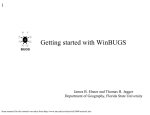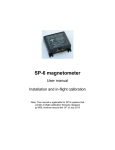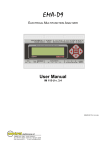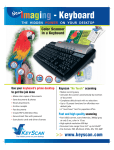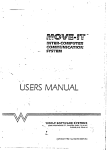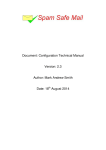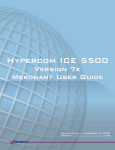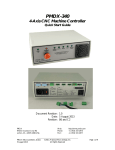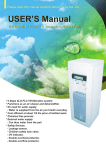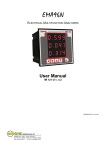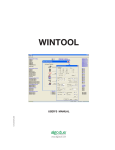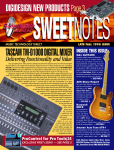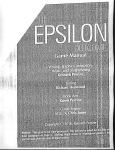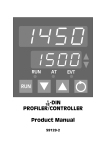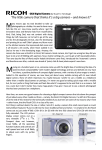Download General Description of Bookwin5
Transcript
The Applied Microsystems Software Book Applied Microsystems started writing software for building management systems in the mid1970s, before the PC, of course, and also around the time when the microprocessor was first appearing on the scene. Software used to reside inside memory chips which had physically to be changed and our clients from this period were very dependant on us to creat the necessary modifications when walls and smoke detectors in a shopping centre were moved, for example. When the PC first appeared on the scene it was basically a text-only device (graphics and, of course, Windows came along later) so although by this time we were able to place software in a PC, we still had to provide graphics on a separate and very expensive colour terminal the contents of which were difficult to change. Now, the same clients who have used our equipment for 25 years can make changes to their building setting under Windows. It was a great joy to them when they realised they no longer had to phone or fax us for every small change to the physical layout of the building. Shopping centres go through many changes in their lifetime and they are now able to edit their database of sensors around the building. This is normal practice now, of course. The image is is a ground floor plan of a shopping centre in the Middle East. Cover image: a side view of the same building No site visits for software upgrades and no compulsory training days! The same freedom is available to our clients today. Site visits are not required for upgrading software and changes to the working parameters of the system are totally under the control of you, the client. We never insist on training days if changes are made. We very rarely charge for software upgrades. If a client comes to us and asks for something which is not currently provided then we are often in their debt as we will normally add it on to the next version and make the package even more attractive! Sometimes, of course, a client may ask for something which is specific to their site and which would not be of benefit to other users. Many of our clients now have email addresses on the Internet and software is delivered as attachements to email - much easier than posting floppy disks! Prices An important aspect of writing software is to make it common to a large number of clients and let them shape it to their own site. That way we write one program instead of a new one for each new client. One of our manufactured products is the CM50 autolocator which has to connect to many different tape machines in recording studios. However, there is only one software program, the studio owner sets it to their machine and the software automatically calls up a library of functions specific to that machine. You will find our prices very attractive, not because the facilities are limited but because we use and reuse modules from our extensive library of software which has been built up over many years. We usually assume the client will provide their own hardware as this can then be covered by a maintenance contract from the supplier but we will always be happy to discuss requirements - most of our software requires a minimum of Windows 95 which is more or less the common standard. The software runs very happily across a bog-standard Windows network. 2 All dates are stored with 4-digit years - we had to do this quite some time ago as some of our clients used to take covenants before 2000 with renewal dates well into the new century. All our software is ‘native’ 32 bit Windows software, it is not DOS-based and then placed inside Windows. Therefore you have all the benefits of Windows in addition to our own software. ‘Cut and Paste’ is a good example of that - it performs correctly in all our programs. Many years ago, the client was totally dependant on the software provider to make changes for them and provide the relevant disks or chips. There is no reason why this should be the case now but some suppliers still maintain a mistique about software and insist on site visits, training days and such like. We hope you will like our open and simple approach - remember your PC is your slave, not your master! The screen illustrates a database and sales team system allocating a complex set of commissions. Bookwin5 - The Database & Booking Software Package We make no secret of the fact that we have entered the leisure industry quite recently but we are no newcomer to Windows software. The following is a brief description of Bookwin5, for more information please see the User Manual either on our web-site or by mail on request. For an explanation of terms see the index of terms on the last page. Let us consider a typical sports centre and see how the Bookwin5 software package handles the various elements of the centre. The Membership Database All members are stored on the system in a very simple format: Surname, First Name, Membership Number, Address, all the usual things! The program enables member search by surname, membership number or by type. Families normally comprise separate members but they are linked in that they all appear at the same time as a reminder. Ie, there is a box which shows either ‘same surname’ or ‘same surname, same address’. All payments are recorded in a separate Table and are matched to members in a special analysis toolbox which carries out searches for overdue payments, membership due for renewal, court fees unpaid etc. A History of all transactions is kept for a set length of time. After this period the user has the choice to remove records older than a specified date. A frequent practice is to dump the history to a printer in order to free up the disk but this can be changed by the user. 3 Non-members may be given a temporary membership number and stored on the database so that, if they return, the record is still there. Do you find label printing a nightmare? - well, with Bookwin5 it is well taken care of and very thoroughly tested. Selective label print-runs are a doddle! The Members Table also shows all payment records against each member whenever that member is selected. The illustration shows the membership database in edit mode - ie, it is now possible to change data. This can be password-protected. The Booking Software Mmost of the membership Table is fairly standard across many different applications, for example social clubs or societies which have membership and payment details but which don’t take bookings. The bookings software enables a number of activities to be booked in many different areas each with different time slots. For a detailed look at how it operates, see the current copy of the Bookwin5 User Manual which you should also find on our web-site. The till in the bar could be linked to the system to enable cost analysis for the whole centre. The till may either be a standard commercial till with a serial interface or our POS software running on a touch screen PC. The choice depends on a number of factors not the least of which is the volume of sales. A typical sports centre would have an office and separate reception area, so a minimum of two PCs are required. Let’s clear up this mystical beast, the Server! Large offices comprising, for example, 15 or more PCs require a central point where all company files are stored - the PCs on each desk are ‘slaves’ to the central system. For a small network of two or three computers there is no need for a server, the back office computer provides this service. You should just ensure that it has plenty of storage and these days this is not a problem. So the office has a standard PC and the reception area could have one of those new flat panel PCs with touch screen. The PC in reception should replicate as closely as possible the paper booking forms that everyone understood before this newfangled computer system came along. It is a source of great sadness to see people cursing computers when all that has happened is that the programmer has simply not given enough thought to who is using the system and has created a complex maze of function keys and mouse clicks. One irritation with using computers (and we experience this in our own office) is having to manage a combination of mouse and keyboard operations which requires a constant movement between two separate controls - we try to keep operations to one or the other where possible. Another requirment of the system in a typical sports centre is that, at the same time as the receptionist is checking in a couple of squash players, a second person should be able to take a booking phone call and share the same PC screen. Windows provides this facility for the £75 or so that you paid for Windows, so why not use it? In the same way that you can have Painbrush AND your wordprocessor open in overlapping windows, so you can have a number of overlapping windows in your sports booking system. 4 The reception PC should also have a card-swipe reader so that visiting players can check in quickly. Another more advanced solution would be smart cards with built-in credit for paying for courts. The reception PC would also be linked to a till cash box. The reception PC does not require a great deal of disk storage; the database of members and bookings resides in the office PC and is backed up regularly onto a 100Mbyte Zip disk (our recommended backup device). We have mentioned earlier that the client should have as much control as possible over the working of the system. The client will discover whether this is the case fairly quickly as, since all sports centres are different and of course change their layout at times, their first job will be to customise the system to their own location. They will not want to phone the software supplier every time there is a subsequent change to be made but we do provide extensive support in the first installation, of course, and this is included in the price. Using Bookwin5 ‘Offline’ in the Back Office Physical areas of the centre are first entered into the system together with the number of ‘sections’ in each area. For example, the main sports hall is marked out for 4 badminton courts but it is often used for five-a-side or fitness training. Therefore you should divide the sports hall into 4 vertical columns just in the same way as you did on paper. The vertical axis comprises the time intervals in which bookings are taken. The offline toolbox simply prompts for the first booking time and the interval for each column and the software does the rest. The toolbox also allows you to creat a list of all possible sports for each area so that, when someone phones to book a badminton court in the main hall the receptionist doesn’t have to plough through sports which are irrelevant for that area. These may also be time and date sensitive, for example, the sports hall may only be used for trampoline on Saturday mornings or for children only at specific times. The online software enables the folllowing features: Entry and cancellation of block bookings. Special days to be entered up to 5 years in advance (eg bank holidays). When checking someone in, the system checks their account to see if there is any money owing. Similarly when someone phones in to book a court it does the same check but this will not prevent the operator over-riding it as in most cases there is no need for draconian mesures - ‘Roger, next time you’re here.....’. Of course, if Roger complains that he did pay for the court in question, the office can go back through the Payment History which automatically records all payments taken. The Financial Package Bookwin5 also includes a financial package which enables analysis of payments with breakdown by type and date - also including or excluding VAT. The VAT rate can be changed retrospectively if necessary and all records are avaialble as an export file in Access or Excel for transporting to an external finance system - for example, the local authority under which the centre operates. Special Requirements Golf Clubs We’ve discussed how a sports centre can be run from a database of members and a booking system on the same computer. How does this work for a golf club? Typically a golf club will have a greater emphasis on competition than the average sports centre. The notice board will be full of various competitions during the week, many of which are linked to members’ 5 handicaps which then may be changed as a result. The clubhouse will be a centre for social functions often combined with presentations of prizes. The membership database is the same for all sports but, for a golf club, there is a special field for storing a member’s handicap and also their competition results. Course bookings are run just in the same way as in a sports centre - the golf club may well have more than one course and so each course will be allocated to a sports ‘zone’ together with the relevant time intervals for bookings. These will typcally be at a shorter interval than in a sports centre but this is no problem for Bookwin5. Bookwin5 can be used to print out competition announcements with spaces for entries then store and log the results. Most golfers are happy to spend a few moments working out Stableford scores, for example, over a beer but the program would also be able to carry out this work. Information on the golf course, the lengths, stroke index etc may also be stored in Bookwin5. For a golf club, where bookings and also sales such as clothing and club sales, golf range and lessons are all normally handled in the pro-shop we can offer a choice of having all transactions on the computer or a link to a conventional till. Modern tills are able to record all these transactions as different types of sales and the data may then be down-loaded into Bookwin for analysis later. As with all software there are probably things that we haven’t thought of or particular requirements that you need. This is not normally a problem as the changes are just patched into the main copy of Bookwin5 which recognises individual clients - there is only one version current at any one time - any specific requirements are then ‘activated’ for your particular site by your personal software key or ‘dongle’ as it is usually called. See a description of the use of the dongle in your user manual. Security The system has a number of access levels each of which is password-protected. The highest level of security applies to those functions which would normally be used in the back office, eg offline and financial work. The reception system may be opened by a specific operator and from then on it is freely open for use. If a second operator shares the work then they should log in but individual bookings are not normally logged by operator as this would require a separate key press but, if a client requires this then it can be added at no extra cost. We are obviously very receptive to any special requests. Notes on the POS section of Bookwin5 A few ideas on a PC-based POS system. The inventory database holds information on all your products together with a local product code. We would expect that commercial products (which all carry a bar code) will be converted automatically to the local inventory code by means of a cross-reference. Product which includes more than one sub-section (eg beer and lager which has a choice of halves or pints) would actually appear in the inventory as two separate items. This would seem to be making extra work for the software but, in fact, each item in the inventory is also linked to a key on the POS keypad. The bottom section of keys (34-43) is only visible if the first key pressed requires a second choice. The top 4 keys are pre-sets which determine the contents of keys 4-33. This enables the main area of keys to show those products which are relevant to the sales area where the till is located. The keypad is like a tree which provides only those choices which are relevant. 6 A typical transaction: Assuming the bar till is already activated to show the Bar provisions. 2 pints of John Smiths and 2 packets of crisps - what flavour do your have? Key 5 is pressed, which then activates keys 34 & 35 to provide the choice of pints or halves. Press key 35 (1 pint) press Multiply and the display will show the sub-total. Now the crisps: Press key 4 and keys 34 to 36 will now show the choice of flavours. Since it is directly linked to the inventory, it will show only those flavours which are in stock (or as an alternative, show all flavours but ‘grey-out’ the flavours which are not in stock. The display now shows the sub-total. If the customer wants 2 different flavours then there is obviously no need to return to the Crisps key (key 4). Press Enter to complete the transaction. This is unlikely to happen in the bar but some sales in the shop may be on account and the till will offer the choice of cash or credit. In the case of credit, the transction will carry the member’s number and will show up as a debit on their account. What records are contained in the inventory database? Product ID This is the code number (eg 3 or 4 digits only) to which the product is refered locally. Bar Code If the item is a commercial product with a bar code on the packing then you may enter the bar-code here (the system will allow you to record the code directly from the bar code reader rather than having to enter it manually). Once the commercial bar code has been read (when the product is sold) the transaction will be refered to by the local code. Product Description A full description of the product including any special notes. Ie it’s dangerous to drink more than 12 pints on the same day. Key Legend This is how you want the product to appear on the key legend Key Number This is the key which is allocated to this product. Mother This is the ‘mother’ under which this key resides. If it is in the main bank of keys then the mother will be one of the top 4 keys, if the key is in the sub-menu block of keys (34-43) then the mother key will be in the main bank of 4-33). All keys have a mother apart from the 4 keys at the top. 7 Some of the allocation of keys will be semi-automatic - ie, users won’t need to think in terms of key numbers but simply press the relevant key while in ‘programming’ mode. Current Stock This amount is modifed actively as sales take place or as deliveries are made so can always be relied upon to reflect the current stock. Maximum Stock When re-ordering stock, the system will subtract the current stock from the Maximum stock to give an ideal re-order value but this would only be a rough guide. Minimum Stock This is the stock level which would trigger a re-ordering reminder. Price This is the price net of VAT Discount Price There is an oportunity to enter an alternative price, eg members’ special price. If the system sees an amount here it will offer the choice on the cash register if (eg) a member’s number is entered. VAT Rate May be zero or 17.5 or any other rate if introduced. Bought-in price This is useful in calculating if the centre is making any money! Notes on tranasctions All transactions in the centre whether they are bookings, sales of equipment or bar sales end up on the same Transaction database so are available for analysis in many different ways. This database is able to handle thousands of records but the system software is able to extract the relevant data very quickly. After a time, the system manger may choose to free up some disk space and dump the records to paper. The system allows the manager to delete records older than a chosen date Notes on booking time slots Each zone may have any number of preset time templates or timebands, as we call them. Only one timeband may be active at any one time, of course, but the zone may select a different timeband on a daily basis. For more details see the (www) online version of the Bookwin5 User Manual. Attendance One important factor for a sports centre is attendance and this is calculated in a number of ways: Against each sport in the main sports list is stored the normal number of people who are attending, for example Squash=2; Badminton=3, etc. For these sports the number of people attending is automatically added to the Transaction database at the time of booking. If they subsequently cancel or fail to show then this will also be recorded leaving the actual total who attended in these 2 sports. Attendance for group activities where the numbers may vary is handled as follows. The number expected is added manually when the booking is made and then automatically when the group arrives if the price 8 is dependant on the number attending. If the booking is for a fixed price for the sports zone then the actual number attending is manually entered aganist the transaction. In all cases, however, each booking event (ie each transaction) has the number of people attending stored in the transaction record and therefore later analysis is very easy - by date, by month, by sport, by type of member etc. Reports may then be printed to A4 sheets for summaries. Summary of terms. Database: This term refers to a collection of tables under one ‘umbrella’. The database comprises a single file in your PC, so it is very simple to copy to other machines or to save onto a disk. The file format is identical to Microsoft Access. In the earlier Foxpro and Dbase style of database, one could end up with a large number of files each of which was called a ‘database’, so this method of collecting everything under one file is very convenient. Table: A Table comprises a collection of records. Each record refers to a single item (eg a single client or a single item of stock). Record: A record comprises a collection of fields. Each field is normally designated to contain either text (in which case you need to decide the maximum length) or a number. Typical field names would be: ‘surname’, ‘phone number’, ‘post code’ etc. Othe field types store time/date format and logical (true/false) fields. Index: Indexes are files which are contained within the database. A number of indexes can be attached to each table. The index is a device to set the order in which you view the records in a table. However, it does not change the table in any way. Typical indexes would be ‘in order of surname’ or ‘in order of membership number’. Indexes are used to search for a particular record by ‘surname’ or by ‘membership number’, for example. For more details on Bookwin5, see the current User Manual which is published on our web-site goto Database & Booking Software from the home page and select the User Manual pdf option. 9









